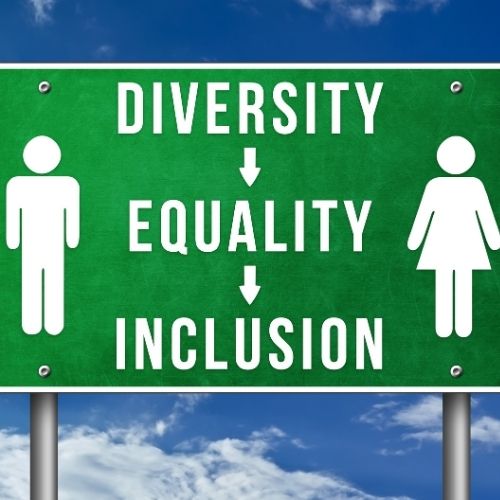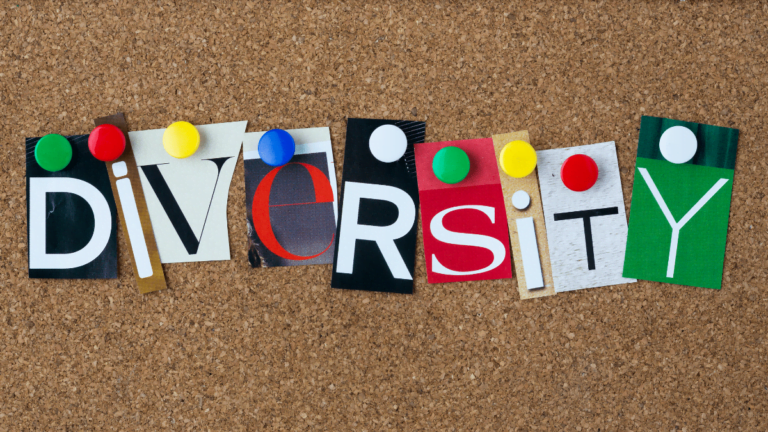Why is diversity in the workplace important? First, let’s talk about what workplace diversity is. Diversity means different. In the workplace, it means hiring people of various races, genders, ethnicity, age, and sexual orientation.
So why is it important to hire different types of people?
There are so many advantages to a diverse workplace. Diversity and inclusion strengthen the workplace. Not only does it benefit an organization but it’s also the right thing to do. It provides unique challenges, but the benefits outweigh the negatives.
Jump To Section
Advantages of Diversity in the Workplace

1. Larger Hiring Pool
As a leader, you know the importance of finding the right people. But here’s the thing: if you’re only looking at one type of candidate, you’re missing out on a world of talent.
Think about it. Every person has a unique story, skills, and way of thinking. When you open your mind to different backgrounds, you’re not just filling a position. You’re bringing in fresh ideas and new perspectives.
I’ve learned this firsthand. Once, I expanded our search beyond the usual suspects. We found an amazing team member who brought solutions we’d never even considered. It was a game-changer.
Here’s my challenge to you: in your next hire, look beyond the obvious. Seek out people who think differently. You might be surprised at what you find.
Remember, diversity isn’t just a buzzword. It’s about valuing each person’s unique gifts. When you do this, you create a team that can tackle any problem.
So, widen your net. You’ll not only find great talent, but you’ll also build a stronger, more innovative team. And isn’t that what great leadership is all about?
Click here for more information on conducting an excellent interview to find the best person for the job.
2. Different Perspectives
It’s not just about having different faces in the room. It’s about hearing different voices and ideas.
Here’s the thing: your team is full of hidden gems. Each person has a unique way of seeing the world. Your job? Dig for those treasures.
Ask yourself: Am I really hearing everyone? Do my team members feel safe sharing their ideas?
Try this: In your next meeting, challenge yourself to hear from everyone. You might be surprised at what you learn.
Remember, it’s not enough to have diversity. You need to make it count. Create a place where every voice matters. Where wild ideas are welcome.
When you do this, magic happens. Problems get solved in new ways. Creativity soars. Your team becomes unstoppable.
So, be the leader who listens. Who values each unique voice. It’s not always easy, but it’s always worth it. That’s how you build a team that can change the world.
3. Improves Productivity
Let’s talk about making your team more productive. It’s not just about working harder. It’s about working smarter, together.
I’ve seen it firsthand. When you bring together people with different skills and backgrounds, amazing things happen. They solve problems in ways you never imagined.
Think about it. Each person on your team has their own special talents. When you mix these talents, you create a powerhouse.
Here’s a secret I’ve learned: happy employees are productive employees. When people feel valued, they give their all. They come up with great ideas. They work faster and better.
But it’s not just about the work. It’s about connecting with customers too. A diverse team can speak to all kinds of people. That means more business and more growth.
So, here’s my challenge to you: Look at your team. Are you using everyone’s talents? Are you making everyone feel important?
Try this: Ask each team member what they do best. Then, find ways to use those skills. You might be surprised at what your team can do.
Remember, productivity isn’t just about numbers. It’s about people. When you value each person’s unique gifts, you’re not just building a team. You’re building a force to be reckoned with.
That’s how you become a true leader. That’s how you change the game.
4. Increased Creativity
Let’s talk about innovation and creativity. It’s not just for artists. It’s your team’s secret weapon.
I once led a team that was stuck. We needed fresh ideas. So, I mixed things up. I brought in people from different backgrounds. Suddenly, the ideas started flowing.
Here’s the thing: everyone thinks differently. That’s good. When you put those different minds together, magic happens.
Think about it. Jane from accounting sees things one way. Tom from sales sees them another. Put them together, and you get ideas neither would have alone.
Creativity isn’t just fun. It’s how businesses stay ahead. It’s how you solve problems no one else can. It’s how you stand out.
So, here’s my challenge to you: Look at your team. Are they all the same? Or do you have a mix of thinkers?
Try this: Next time you have a problem, ask everyone for ideas. Even the quiet ones. You might be surprised who comes up with the winning solution.
Remember, creativity isn’t about being artsy. It’s about thinking differently. It’s about seeing new paths where others see dead ends.
That’s how you become a leader who makes a difference. That’s how you build a team that changes the game.
So, embrace the power of different minds. Let creativity flow. Watch your team soar.
5. Better Employee Performance
Let’s talk about getting the best from your team. It’s not rocket science. It’s about creating a company culture where everyone feels at home.
I’ve seen it happen. When people feel they can be themselves at work, magic happens. They work harder. They care more. They stick around.
Here’s a secret I’ve learned: People need to feel like they belong. When they do, they make friends at work. Collaboration soars. They feel like they are part of something bigger. That’s when they really start to shine.
Think about it. When was the last time you shared an idea if you felt out of place? But when you feel valued, you speak up. You solve problems. You make things better for everyone.
As a leader, it’s up to you to embrace diversity and set the tone. Show your team that everyone matters. Listen to them. Really listen. Let them know their ideas count.
Remember, your team isn’t just a group of workers. They’re people. Each one is unique. Each one has something special to offer.
That’s how you build a team that performs. That’s how you become a leader who makes a difference.
So, make your workplace a home for everyone. Watch your team grow. Watch them excel. That’s the power of belonging.
6. Reduced Employee Turnover
Let’s talk about keeping your best people. It’s not just about saving money. It’s about building a dream team.
I’ve been there. Watching great employees walk out the door hurts. It costs time, money, and morale. But here’s the thing: happy employees stick around.
Think about your best worker. The one who knows everything. The one clients love. What if they left? Ouch, right?
That’s why keeping people matters. It’s not just about skills. It’s about relationships. It’s about knowing how things work.
Here’s a secret: People who stay become your heroes. They solve problems faster. They know the shortcuts. They teach others.
I once had an employee who’d been with us for years. When a crisis hit, she knew exactly what to do. She saved the day. That’s the power of experience.
Try this: Ask your long-timers what keeps them around. You might learn something valuable.
Remember, your team isn’t just a bunch of workers. They’re the heart of your business. Each one matters.
So, focus on keeping your people happy. Give them reasons to stay. Watch them grow. Watch your business thrive.
7. Improved Organizational Image
Let’s talk about making your company shine. It’s not about looking good on paper. It’s about building a team that reflects the world we live in.
I’ve seen it happen. When you bring together people from all walks of life, magic happens. Your company becomes a place where everyone can thrive.
Here’s the thing: diversity isn’t just the right thing to do. It’s smart business. In our connected world, your team should look like your customers.
Think about it. When was the last time you walked into a store and saw people just like you? It feels good, right? That’s what we’re aiming for.
Try this: Look around your office. Does your team reflect the world outside? If not, think about how you can change that.
So, build a team that looks like the world. Watch your company grow. Watch it connect with more people.
That’s how you become a company people trust. That’s how you become a leader who makes a difference.
8. Increases Individual Insights
Let’s talk about how diversity and inclusion in the workplace can change you. It’s not just about your company. It’s about making our world better.
I’ve seen it happen. When you work with people from all walks of life, you grow. You learn. You see the world differently.
Here’s the thing: work is where we spend most of our time. It’s where we make friends. When those friends are different from us, something amazing happens. We start to understand each other better.
Think about it. Have you ever had a chat with a coworker from another country? Did you learn something new? That’s what we’re talking about.
Try this: Next time you’re at work, talk to someone different from you. Ask about their life. You might be surprised at what you learn.
Remember, your workplace isn’t just a place to earn money. It’s a place to grow as a person. Each conversation is a chance to learn.
So, embrace the diversity around you. Watch yourself grow. Watch your understanding of the world expand.
Challenges of Diversity in the Workplace

Of course, having a diverse workforce doesn’t come without its own set of challenges. Although we would like everyone to be open and accept others, it’s not the case with everybody. There are individuals that will have difficulties with a diverse workplace due to their own biases. That’s where it’s extremely important for managers and organizations as a whole to not tolerate people that don’t foster an environment of inclusion.
When you get people that think differently together you may experience some friction. A little conflict can be healthy but when it starts to become excessive it’s up to the manager to help resolve the conflict and ensure it doesn’t get to an unhealthy level. As a manager, it’s up to you to create an environment where everyone’s opinions and ideas are valued and respected. This will help eliminate friction.
Tips to Create a Diverse Workplace

1. Hire Diverse People
Diversity starts with hiring. Don’t limit yourself to hiring a specific type of person. Look for the best person for the job. Their religion, gender, sexual orientation, or any other thing that makes them different doesn’t affect how well they will do the job in most cases.
There are some jobs where you do have a specific type of person in mind but those jobs are rare and you should still be careful about getting too specific in those instances. For example, there are many men that make great nurses and there are many women that make great heavy equipment operators. These jobs were considered gender-specific at one time but it turns out both genders are very capable in most cases.
Click here to learn strategies to conduct an awesome interview and hire the best person for the job.
2. Forget Stereotypes
Stereotypes can be incredibly harmful and damaging when it comes to promoting diversity and inclusion. Stereotypes are preconceived notions that are based on superficial characteristics such as race, ethnicity, gender, religion, or any other factor. Stereotyping people can lead to harmful and unfair treatment, discrimination, and exclusion.
To foster a truly diverse and inclusive workplace, it’s important to clear stereotypes from your mind. People are all different and unique, regardless of their background or characteristics. It’s not fair to group people into certain categories simply because of their race, ethnicity, gender, religion, or any other factor.
Instead, it’s important to get to know people as individuals and to judge them based on their actions, skills, and abilities. This means taking the time to learn about their background, experiences, and perspectives, and to recognize and value the diversity they bring to the workplace.
One of the key ways to clear stereotypes from your mind is to challenge your own biases and assumptions. This means being open to learning about different cultures and perspectives and being willing to engage in uncomfortable conversations about race, gender, and other sensitive topics.
It also means promoting a culture of respect and inclusivity, where everyone feels valued and respected for who they are. This can be achieved through training, policies, and practices that promote diversity and inclusion, such as unconscious bias training, diversity and inclusion committees, and mentorship programs.
3. Team Building
A great way to get your team working on the same page is through team building activities. These can be done in the office or out of the office. They are great for building trust among members of the team because employees must rely on each other to win the games. It is also a great icebreaker because people have fun together and it builds that foundation making employees more comfortable with each other.
4. Add Diversity to Company Website

Talk about how you and your company promote and welcome diversity on your company website. Many prospective employees will look into a company before accepting a job. They will see this and feel more welcomed. Also, this will show others that the company supports diversity in the workplace and will help boost the company’s image.
You also need to express that you welcome diverse applicants in your job postings. This will ensure you get applicants from all backgrounds and beliefs to apply.
5. Avoid Using Quotas
Although quotas may seem like they are beneficial for companies, they can hurt diversity. You should never limit yourself to hiring a certain number of minorities. Hiring the right person for the job is a much better strategy. I’m a firm believer that you should hire the best person for the job no matter what their backgrounds or beliefs are.
6. Recruit in Multiple Ways
If you recruit new employees using the same methods, you may get the same type of applicants each time. Use multiple forms of recruiting employees. You can use methods like advertising in the newspaper, advertising online on sites like
7. Encourage Referrals From Current Employees
Encourage your good employees to refer people to apply for your company. This works especially well if you already have a diverse workforce because typically the people that get referred by your current employees will be their friends and family. These referrals can help with the recruiting process because these prospective employees come with a known reference.
8. Conduct Exit Interviews

You can get a ton of information that will help you make the organization better during an exit interview. People are a lot more willing to speak up about what they see wrong and what can be improved when they are on their way out the door. Use this time to find out how you and the company are doing on producing an environment of inclusion. As a leader, you need to go into an exit interview with an open mind and don’t take offense when somebody says you’re doing something wrong. Use it as an opportunity to grow and get better.
Wrapping it Up
Although a diverse workforce can have its own set of challenges, the benefits far outweigh the negatives. Not only is it better for you and the company you work for but it’s also better for society. I hope this article has changed your question from “why is diversity in the workplace important” to “how can I make my workplace more diverse”.
If you enjoyed this article on why diversity in the workplace is important please share using the buttons below.


